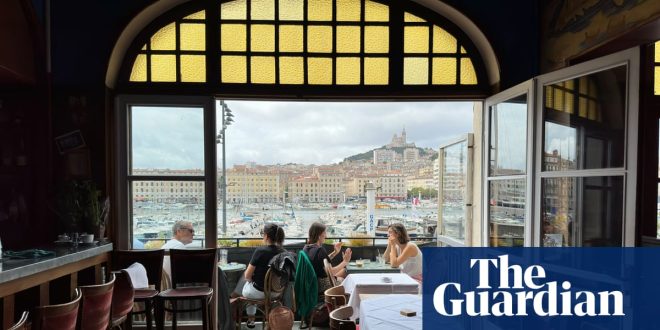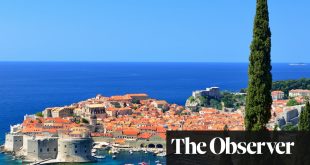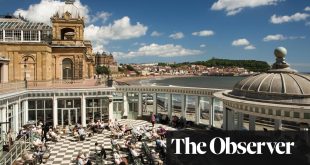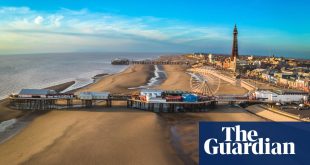‘Tell me what you eat, and I shall tell you what you are,” wrote philosopher-gourmand Jean Anthelme Brillat-Savarin in 1825, and this is particularly true of today’s Marseille: food is the key to understanding the city. The kesra flatbread grilled by grandmothers from the Algerian diaspora in Noailles. The pizzas scarfed by Olympique de Marseille jersey-clad teens and families on the rocky beach at sunset. The waterfront restaurant that has served fish to generations of marseillais for more than 80 years. These foods embody the heritage, diversity and conviviality of Marseille.
I moved to Marseille from the US seven years ago, following in the footsteps of celebrated American food writers MFK Fisher and Julia Child, who were similarly seduced by the city. Exploring its flavours in my articles has broadened my culinary education, as did translating Taste the World in Marseille into English. My friends joke that I’m a “living guidebook”. I also lead food tours with Culinary Backstreets since, apart from eating, the best way to understand this complex city is to walk it.
Marseille’s food scene has boomed in the past few years, sparked by young, self-taught chefs lured by the city’s diversity and lower costs. But while I sample these new tables for my work, given the choice I tend to dine à la bonne franquette, choosing the no-fuss spots this city does so well.
The first stop of the day is for coffee. Hidden away on the first floor of the Hotel Bellevue above the bustling Vieux-Port is La Caravelle, which was a cabaret venue for sailors in the 1920s. Old murals of vintage boats and the southern French coastline decorate the all-day cafe. On nice mornings, I grab a seat on the sliver of a balcony for an orange pressé, a croissant and a coffee, and admire the view of the Bonne Mère, the famous church that soars above the port.
On the port’s esplanade, I walk past fishmongers hawking sea bream and squid and a plaque commemorating Marseille’s founding by Phocaeans in 600BC, which “radiated civilisation throughout the Occident”. At Patisserie Journo, a Tunisian-Jewish hole-in-the-wall bakery, David offers me a tray of cornes de gazelles, crescent-shaped almond cookies that coat my face in powdered sugar. When I’m there for lunch, I have a tuna- and veggie-packed Tunisian sandwich, deliciously drenched in olive oil. Hot days call for citronnade, Tunisian fresh lemonade.
I stroll past the boutiques on Rue Paradis to the tree-lined Cours Pierre Puget, an elegant avenue named for the 17th-century Marseille-born urban planner and sculptor. Station Uvale is the last remaining grape juice bar in France – a green wooden stand that has been pouring fresh-pressed grape juice since the late 1940s. Known as a cure-all, jus de raisin concentrates the natural sweetness of the grapes without added sugar. The juice bar also acts as a non-alcoholic neighbourhood watering hole, “a gathering place”, smiles owner Yannis Amokreze.
As I head west, the opulent, neoclassical buildings give way to graffiti-lined streets. The Noailles district is known as the “belly of Marseille” for its central location and array of foodstuffs. There are Vietnamese spring rolls at Tam-ky, peanuty Ivorian mafé at Mama Africa and Corsican figatelli (pork liver sausage) at Au Grand Saint-Antoine. At Pizza Charly, calentica, a chickpea flan of Hispano-Algerian origins, illustrates the influence of travel and trade on Marseille’s cuisine. People and their recipes have come through the port for 2,600 years, their diversity giving Marseille its signature sauce on and off the table.
Up La Canebière, the city’s main artery, the white Saint-Vincent de Paul church (worth a visit for the improbable animals – bats and langoustines – carved on its doors) towers above La Boîte à Sardine. The chalkboard menu at this nautically kitsch space invites you to dive deeper into local cuisine than Marseille’s ubiquitous bouillabaisse. Co-owner and former fishmonger Fabien Rugi sources the freshest catch from small fishing operators. His business partner, chef Céline Bonnieu, stuffs the sardines with local goat’s cheese, makes octopus caillettes (sausages) and swaps potatoes for panisse, the city’s famous chickpea fritters in its signature fish and chips. All are served with the bonhomie of a booze cruise. Solo diners will appreciate the counter seating.
after newsletter promotion
Continuing to the La Plaine neighbourhood, I pass blue and white murals for the revered football club, Olympique de Marseille (OM). The square is also home to the city’s cheapest glass of pastis, though I prefer sipping this legendary tipple in my own neighbourhood, Chave, one of the 111 villages that make France’s second-largest city feel like a small town. I join regulars under the plane trees outside Le Dernier Métro, the historic bar du quartier that is packed at apéro hour, the post-work drink that is sacred in France.
When I’m in the mood for wine, bar à vin Carnage serves natural wines and charcuterie such as porchetta made in-house by owners Auregan Dean and Mathieu Zurcher, who are part of Marseille’s new gastronomic guard.
For a pizza evening, my friends and I take the Corniche Kennedy coastal road to Chez Zé, a family-run spot at the edge of Calanques national park that has been going since the 1960s. Following tradition, we order pizza to share as an appetiser – the classic moitié-moitié, part anchovy, part emmental, is Marseille’s briny and French spin on the snack brought here by Italian immigrants in the 19th century.
Other Provençal dishes include supions à l’ail (garlic-sautéed small squid), moules marinières, and aubergine à la parmesane baked in the same wood-fired oven as the pizzas. The waiters offer us limoncello at the end, a digestif to soothe our stuffed bellies and, more importantly, share a dose of conviviality. Which is the most important ingredient in Marseille.
 Top Naija News – Nigeria News, Nigerian News & Top Stories Top Naija News – Nigerian Newspapers, Nigerian News. topnaijanews is a daily Nigerian newspaper covering Latest News, Breaking News, Entertainment, Sports, Lifestyle and Politics.
Top Naija News – Nigeria News, Nigerian News & Top Stories Top Naija News – Nigerian Newspapers, Nigerian News. topnaijanews is a daily Nigerian newspaper covering Latest News, Breaking News, Entertainment, Sports, Lifestyle and Politics.




